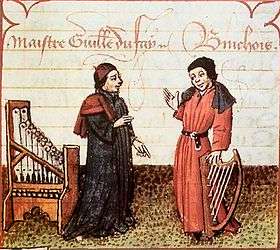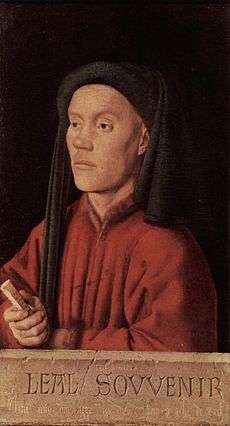Gilles Binchois

Gilles de Binche (called Binchois; also known as Gilles de Bins; ca. 1400 – 20 September 1460), was a Netherlandish composer, one of the earliest members of the Burgundian school and one of the three most famous composers of the early 15th century. While often ranked behind his contemporaries Guillaume Dufay and John Dunstable by contemporary scholars, his works were still cited, borrowed and used as source material after his death.
Life

Binchois was probably from Mons, the son of Jean and Johanna de Binche, who may have been from the nearby town of Binche. His father was a councillor to Duke Guillaume IV of Hainault, and also worked in a church in Mons. Nothing is known about Gilles until 1419, when he became organist at the church of Ste. Waudru in Mons. In 1423 went to live in Lille. Around this time he may have been a soldier in the service of either the Burgundians or the English Earl of Suffolk, as indicated by a line in the funeral motet composed in his memory by Ockeghem. Sometime near the end of the 1420s he joined the court chapel of Burgundy, and by the time of his motet Nove cantum melodie (1432) he was evidently a singer there, since the text of the motet itself lists all 19 singers in place at that time. He eventually retired in Soignies, evidently with a substantial pension for his long years of excellent service to the Burgundian court.
Music and influence
Binchois is often considered to be the finest melodist of the 15th century, writing carefully shaped lines which are not only easy to sing but utterly memorable. His tunes appeared in copies decades after his death, and were often used as sources for Mass composition by later composers. Most of his music, even his sacred music, is simple and clear in outline, sometimes even ascetic; a greater contrast between Binchois and the extreme complexity of the ars subtilior of the prior (fourteenth) century would be hard to imagine. Most of his secular songs are rondeaux, which became the most common song form during the century. He rarely wrote in strophic form, and his melodies are generally independent of the rhyme scheme of the verses they are set to. Binchois wrote music for the court, secular songs of love and chivalry that met the expectations and satisfied the taste of the Dukes of Burgundy who employed him, and evidently loved his music accordingly. About half of his extant secular music is found in the manuscript Oxford, Bodleian Library MS Canon. misc. 213.
References
- David Fallows, "Gilles Binchois," The New Grove Dictionary of Music and Musicians, ed. Stanley Sadie. 20 vol. London, Macmillan Publishers Ltd., 1980. ISBN 1-56159-174-2
- Gustave Reese, Music in the Renaissance. New York, W.W. Norton & Co., 1954. ISBN 0-393-09530-4
- "Binchois Studies", Edited by Andrew Kirkman and Dennis Slavin. Oxford, Oxford University Press: 2000.
External links
- Biography and related information about his music
- Classical Composers Database: Binchois' entry
- Biographical information
- Free scores by Gilles Binchois in the Choral Public Domain Library (ChoralWiki)
- Official webpage